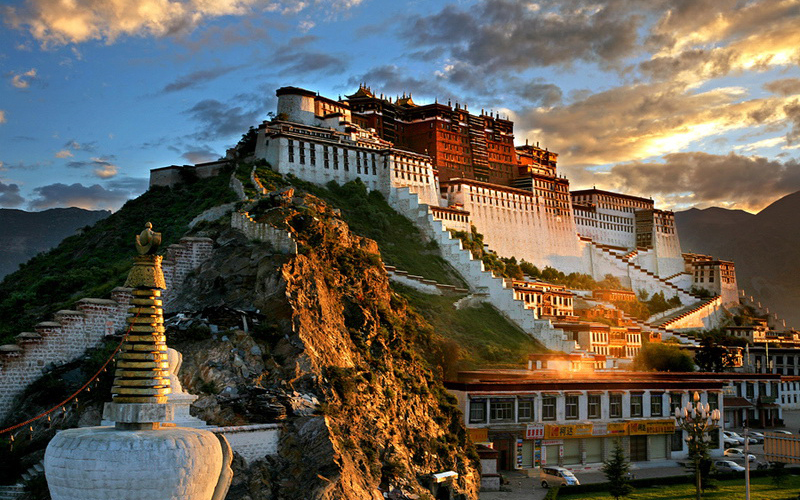The great Wall of China
One of the most grandiose buildings of mankind
The Great Wall is a symbol of China’s national pride and one of the most popular tourist destinations. It was built over several centuries, that is, it is a heterogeneous formation.
To date, the length of this defensive object is 21,000 km. Some sections are almost completely destroyed, others are well preserved, others have been restored and look more like models of what once existed.
Tourists, as a rule, are brought to the Minsk section (a section of the wall that was built during the era of the Ming rulers). It was created approximately between the 14th and 16th centuries. In its form, the wall in this place is similar to the one that existed 400–500 years ago, but this is a completely restored structure, nothing remains of the former wall.
For scientists, a section of the wall of the Han era is of interest. It is located on the border of Xinjiang, it almost never rains there, so the military facility has been preserved quite well. But getting there is not easy.
Forbidden city
Taoist shrine. For a long time, the Forbidden City in Beijing was home only to the emperor and his entire family; ordinary people were not allowed to enter. Everyone who tried to enter the sanctuary was killed.

There are 9999 structures on the territory of the Forbidden City. The central building of the ensemble is the Imperial Palace in the form of a rectangle with watchtowers at the corners.
In 1949, at the Gate of Heavenly Peace opposite the Forbidden City, the People’s Republic of China was proclaimed. At this time, it was decided to completely destroy the Forbidden City, and to set up a park in its place. Member of the State Council Zhou Enlai managed to challenge the decision.
During its history, the buildings of the city were destroyed by fires and vandalism, so most of the buildings and artifacts that have come down to us date back to the 17th-19th centuries.
Shaolin
The most famous monastery in the world
The most famous Buddhist monastery in the center of China was founded by a monk from India. He preached for several decades in one place before the Chinese emperor ordered the construction of the Shaolin Monastery on Mount Songshan for him. This is where the martial art of kung fu originated.
Now people from all over the world come to Shaolin to learn this type of martial art. Anyone can enter if there are no health contraindications.
You can visit Shaolin as part of a tourist group by joining an excursion group. On the territory of the monastery, it is important to observe a number of rules. Guests are allowed to visit meditation halls and prayer rooms, but they are not allowed to make noise or have fun. Photos can be taken, but only with the consent of the monk who accompanies the tourist groups.
Terracotta Army
Clay statues 1.9–1.95 meters tall
Near the city of Xi’an, in the province of Shaanxi, there is an area where at least 8,100 full-size terracotta statues of Chinese warriors and their horses are buried.
This find was discovered relatively recently – in 1974. The first stage of the excavation took place in 1978, when 6,000 statues were discovered. The second phase began in 1985, when another 2,000 statues were found, including statues of musicians, acrobats and horse trainers. Excavations continue to this day.
What is the meaning of this building? The first Chinese emperor ordered that his entire army be buried with him. But he was persuaded to abandon this barbaric act, he agreed that instead of real people, statues of the army, horses and courtiers would be buried with him in the ground.
The monument looks large and makes an indelible impression. The Terracotta Army is without exaggeration one of the most important sights in China, which is a must-see.

Giant Buddha
Huge Buddha sculpture 71 meters high
The giant Buddha began to be created in 713 in order to protect the fishermen from death. The statue is located at the confluence of three rivers. A dangerous whirlpool formed in this area, in which many local residents died every year.
One of the monks, hoping to protect himself from a natural disaster, decided to create a statue of the Buddha. During the years of his life, he managed to carve a huge statue of the Buddha only to the knees, but later his followers continued his work. A century later, the statue was ready.
The workers, creating the Buddha, threw fragments of rock into the river, thereby slowing down its flows and saving the fishermen from death. So, we can say that the plan worked – the Buddha saved people.
The statue was invisible to the eyes for a long time. She was hiding behind the 13-story Daxiange Temple. But in the 17th century it burned down and the Buddha stepped out of the shadows.
Until 1960, the statue was gradually destroyed. The authorities, realizing that they were losing one of the most beautiful sights in China, started laying drainage structures. Today, the Buddha is not in danger. Every year, several thousand tourists come here to see the large-scale creation of human hands.
